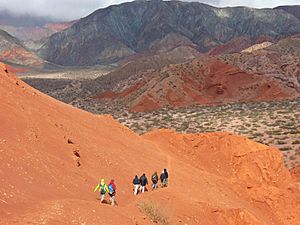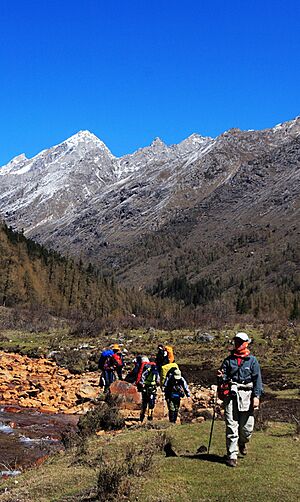Hiking facts for kids


Hiking means walking outdoors, usually in nature or the countryside. It's a great way to explore new places! Some people go for just a few hours and come back before dark. These are called day hikers. Others might go for many days, staying overnight in tents or cabins. Sometimes, big groups of friends or families hike together.
Hiking is a fun way to spend your free time and get some exercise. People who hike, called hikers, love breathing fresh air and seeing beautiful natural sights. They also learn a lot about the plants, animals, and history of the places they visit. Many hikers enjoy testing their bodies and minds on challenging trails. Hiking with friends can make you feel stronger and build great memories.
Contents
Getting Ready for a Hike
Before you head out on a hike, it's important to plan and get the right gear. This helps make sure your adventure is safe and fun!
Planning Your Trip
Planning starts with deciding what kind of hike you want. Do you want a short walk or a long journey? You should look up information about the area. Think about:
- The landscape (is it flat, hilly, or mountainous?)
- The weather (will it be hot, cold, or rainy?)
- What plants and animals you might see
- The type of ground (rocky, muddy, or smooth?)
Based on this information, you can decide what equipment you'll need. It's a good idea to write everything down so you don't forget anything important. Also, choose your route carefully. This is called your itinerary.
What to Bring
Getting ready also means gathering special clothing and equipment. If you're hiking overnight, you'll need to carry more supplies, usually in a backpack. Even for a day hike, a backpack is very useful.
You can find many suggestions for what to bring in hiking books or online. It's smart to check more than one source. Sometimes, you might need to learn how to use certain tools. For example, knowing how to use a compass or a map is a basic skill that's super helpful for finding your way.
Staying Safe on the Trail
Hiking can be an amazing experience, but it's important to be prepared for challenges. Hikers can sometimes get lost, hurt, or face bad weather. That's why safety is a top priority.
It's usually best not to hike alone, especially if you don't have a lot of experience. Hiking with others, especially those who have hiked before, can help you learn and stay safe. Remember, reading about hiking is good, but nothing beats real-life experience. Start with shorter hikes with experienced people to build your skills.
Finding Your Way
Getting lost can be scary and even dangerous. It's very important to check your direction often, at least once an hour, to make sure you're still on the right path.
Portable GPS devices can help you find your way, as long as their batteries are charged. Good maps and a compass are also very useful, but only if you know how to use them!
If you realize you're lost, don't keep walking forward. The first thing to do is try to figure out the direction you were going before you got lost. Then, use your compass and map to find a nearby landmark, like a railway, road, or river, that can help you get back on track.
Images for kids
-
Hiking in the San Juan Mountains, Colorado
-
A hiker enjoying the view of the Alps
-
The Karhunkierros ("Bear's Round"), an 80 km (50 mi) long hiking trail through the Oulanka National Park in Kuusamo, Finland
-
Claife Station, built at one of Thomas West's 'viewing stations', to allow visiting tourists and artists to better appreciate the picturesque Lake District, Cumbria, England.
-
Map of Robert Louis Stevenson's walking route in the Cévennes, France, taken from Travels with a Donkey in the Cévennes (1879), a pioneering classic of outdoor literature.
-
Thoreau walked 34 miles (55 km) to Mount Wachusett, shown here.
-
The King Talal Dam in Jerash lies along the Jordan Trail in Jordan
-
Parts of many hiking trails around Lake Mohonk, New York State, US, include stairways which can prevent erosion
-
Snowshoers in Bryce Canyon, Utah, U.S.
-
Cross-country skiing (including Ski touring) gives access to hiking trails in winter
See also
 In Spanish: Senderismo para niños
In Spanish: Senderismo para niños
















